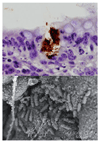Super-shedding and the link between human infection and livestock carriage of Escherichia coli O157
- PMID: 19008890
- PMCID: PMC5844465
- DOI: 10.1038/nrmicro2029
Super-shedding and the link between human infection and livestock carriage of Escherichia coli O157
Abstract
Cattle that excrete more Escherichia coli O157 than others are known as super-shedders. Super-shedding has important consequences for the epidemiology of E. coli O157 in cattle--its main reservoir--and for the risk of human infection, particularly owing to environmental exposure. Ultimately, control measures targeted at super-shedders may prove to be highly effective. We currently have only a limited understanding of both the nature and the determinants of super-shedding. However, super-shedding has been observed to be associated with colonization at the terminal rectum and might also occur more often with certain pathogen phage types. More generally, epidemiological evidence suggests that super-shedding might be important in other bacterial and viral infections.
Figures




References
-
- Karmali MA. Infection by shiga toxin-producing Escherichia coli. An overview. Mol Biotechnol. 2004;26:117–122. - PubMed
-
- Griffin PM, Tauxe RV. The epidemiology of infections caused by Escherichia coli O157:H7, other enterohemorrhagic E. coli and the associated haemolytic uremic syndrome. Epidemiol Rev. 1991;30:60–98. - PubMed
-
- Caprioli A, Morabito S, Brugère H, Oswald E. Enterohaemorragic Escherichia coli: emerging issues on virulence and modes of transmission. Vet Res. 2005;36:289–311. - PubMed
-
- Centers for Disease Control and Prevention. Ongoing multistate outbreak of Escherichia coli serotype O157:H7 Infections associated with consumption of fresh spinach---United States, September 2006. MMWR Weekly. 2006;55:1045–1046. - PubMed
-
- Mead PS, Griffin PM. Escherichia coli O157:H7. Lancet. 1998;352:1207–1212. - PubMed
Publication types
MeSH terms
Grants and funding
LinkOut - more resources
Full Text Sources
Other Literature Sources
Medical

